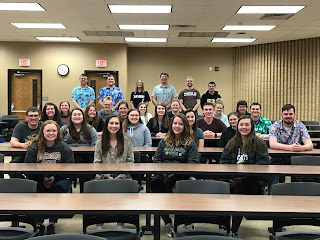Editor's note: The class is currently in an area with extremely limited Internet access. Once they are in an area with better connectivity, we will add more to this post.
2nd editor's note: The class got to an area with better Internet. So we can add the latest chapter to the blog.
18May2019
 |
| Overview of Mt Linton farm broken down into
paddocks |
We started this morning in Te Anau
at our hotel with breakfast served, then departed our hotel and traveled
through to Mt Linton Station. This station has 13,000 hectares, and is the
largest privately owned operation with 105,000 stock units. With having 13,000
hectares, they have over 300 km of maintained road throughout the property. This
station is broken down into: 74,000 sheep, 120 dogs, and 3,000 cows.
 |
| The 12 shearing stations in their main shearing
barn |
Mt
Linton produces 250,000 kg of greasy wool each year. They shear 40,000 sheep
and 30,000 lambs twice a year (or every 6 months). The wool is then contracted
through New Zealand Merino wool. They had 12 shearing stations and it can hold
7,000 ewes under the shed for weather related purposes. Having the shed is good
for making management easier for the shearers. They get 2.5 kilograms of wool
per shearing. They breed for maternal and terminal traits. Romney and Texel are
the maternal breeds, and the Suftex is the terminal breed. They do not
outsource their rams, they only use their own genetics.
 | | |
| The sorting and packing area for the wool |
 |
| This is the working/holding area for the sheep. |
Mt
Linton Station primarily raises Angus cows. They focus on good marbling being
raised on only green grass getting transitioned over from grass to finish on
kale and fodder beets. They are finished at 18 months, and then are sent away
from May to October. They breed their own bulls, and get genetics imported from
Australia. Their loading system is very efficient as they have a stack loading
chute. They did this so they do not have to use the ramp of the trailer so the
cattle don’t slip and get injured. They have had success with not having
bruising on the carcass.
 |
| Looking down from the top ramp of loading chute |
Both the cows and the breeding ewes
are getting one round of AI (artificial insemination) then get put out with a
cleanup bull or ram. All of the breeding stock has EID tags in their ear to
keep records of the history of that animal. They have a 65:35 sheep to cow
ratio on their station.
 |
| Overview of cattle working facil |
Throughout
the year they have 16 full time employees, and then during the summer they get
up to 25 employees. They provide housing on site to the shepherds and feed a
meal to them also. This operation encompasses a full time mechanic and a
fencer.
 |
| The two deck loading chute |
They
train their sheep dogs on voice command and on whistle command. With having 120
dogs, each employee gets assigned dog(s) to further train and use them to herd
sheep. Our tour guide, Jacob, a stock manager, has 12 dogs of his own.
 |
| Landscape of Mt Linton station |
After
our tour, Heather had prepared us lunch which consisted of a whole lamb roast
with three different salads and peppers. She had also provided us with a fruit
skewer, a chocolate cookie, and a carrot cake. After thanking our hosts, we
departed for a three hour bus ride to Miller Flat where we met our farm stay
hosts for the evening.
-Sidney, Anthony, Nicole
 |
| Paddock of sheep |
 |
| Paddock of cattle |














Comments
Post a Comment